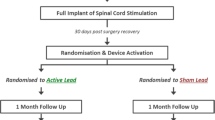Abstract
Summary
Chronic low back pain due to multiple vertebral fractures is of difficult management. Electrical nerve stimulation is frequently used, but its efficacy has never been properly evaluated. In a randomized placebo-controlled clinical trial, we have shown that both interferential currents and horizontal therapy are more effective than placebo for functional.
Introduction
Multiple vertebral fractures almost invariably ensue in chronic low back pain that remains of difficult management. Electrical nerve stimulation is frequently used but its efficacy has never been properly evaluated.
Methods
One hundred and fifteen women with chronic back pain due to previous multiple vertebral osteoporotic fractures (CBPMF) were randomly assigned to either interferential currents (IFT), horizontal therapy (HT) or sham HT administered for 30 minutes daily for 5 days per week for two weeks together with a standard exercise program. Efficacy assessment was obtained at baseline and at week 2, 6 and 14 and included a functional questionnaire (Backill), the standard visual analog scale (VAS) and the mean analgesic consumption.
Results
At week 2 a significant and similar improvement in both the VAS and Backill score was observed in the three groups. The two scores continued to improve in the two active groups with changes significantly (p < 0.001) greater than those observed in control patients at week 6 and 14. The use of analgesic medications improved only in the HT group.
Conclusion
This randomized double-blind controlled study provides the first evidence that IFT and HT therapy are significantly effective in alleviating both pain and disability in patients with CBPMF.

Similar content being viewed by others
References
Melton LJ III, Lane AW, Cooper C, Eastell R, O’Fallon WM, Riggs BL (1993) Prevalence and incidence of vertebral deformities. Osteoporos Int 3:113–119
Huang C, Ross PD (1996) Vertebral fracture and other predictors of physical impairment and health care utilization. Arch Intern Med 156:2469–2475
Pluijm SM, Tromp AM, Smit JH, Deeg DJ, Lips P (2000) Consequences of vertebral deformities in older men and women. J Bone Miner Res 15:1564–1572
Lips P, Cooper C, Agnusdei D, Caulin F, Egger P, Johnell O et al (1999) Quality of life in patients with vertebral fractures. Validation of the Quality of Life Questionnaire of the European Foundation for Osteoporosis (QUALEFFO). Osteoporos Int 10:150–160
Frymoyer JW (1998) Back pain and sciatica. N Engl J Med 318:291–300
Gadsby JG, Flowerdew MW (2000) Transcutaneous electrical nerve stimulation and acupuncture-like transcutaneous electrical nerve stimulation for chronic low back pain. Cochrane Database Syst Rev (2):CD000210
Ghoname EA, Craig W F, White PF, Ahmed HE, Hamza MA, Henderson BN, Gajraj NM, Huber PJ, Gatchel RJ (1999) Percutaneous Electrical nerve Stimulation for low back pain: a randomized crossover study. JAMA 281:818– 823
Melzack R, Vetere P, Finch L (1983) Transcutaneous electrical nerve stimulation for low back pain. A comparison of TENS and Massage for pain and range of motion. Phys Ther 63:489–493
Köke AJA, Schouten JSAG, Lamerichs-Geelenc MJH, Lipschc JSM, Waltje EMH, van Kleefa M, Patijn J (2004) Pain reducing effect of three types of transcutaneous electrical nerve stimulation in patients with chronic pain: a randomized crossover trial. Pain 108: 36–42
Hurley DA, Minder PM, McDonough SM, Walsh DM, Moore AP, Baxter DG (2001) Interferential therapy electrode placement technique in acute low back pain: a preliminary investigation. Arch Phys Med Rehabil 82:485–93
Johnson MI, Tabasam G (2002) A single-blind placebo-controlled investigation into the analgesic effects of interferential currents on experimentally induced ischaemic pain in healthy subjects. Clin Physiol Funct Imaging 22:187–196
Weiner DK, Rudy TE, Glick RM, Boston JR, Lieber SJ, Morrow LA, Taylor S (2003) Efficacy of percutaneous electrical nerve stimulation for the treatment of chronic low back pain in older adults. J Am Ger Soc 51: 599–608
Kloth L (1987) Interference current. In: Nelson R, Courrier D. (eds) Clinical electrotherapy. Appleton & Lange, St Louis, CA, 183–207
Martin D (1996) Interferential therapy. In: Kitchen S, Bazin S. (eds) Clayton’s Electrotherapy. W.B. Saunders, London (UK), 306–315
Hansjürgens A (1999) Electrical differatiation therapy EDT American Academy Of pain management annual clinical meeting 23–26, Sep
Souchard PE. Posture Mézières (1982) Roma (Italy) Marrapese. In: D.E.M.I.
Genant HK, Jergas M, Palermo L, Nevitt M, Valentin RS, Black D, Cummings SR (1996) Comparison of semiquantitative visual and quantitative morphometric assessment of prevalent and incident vertebral fractures in osteoporosis The Study of Osteoporotic Fractures Research Group. J Bone Miner Res 11:984–996
Tesio L, Granger CV, Fiedler RC (1997) A unidimensional pain/disability measure for low-back pain syndromes. Pain 69:269–278
Zambito A, Bianchini D, Gatti D, Adami S, Rossini M (2006) Interferential and horizontal therapies in chronic back pain: a randomized, double blind, clinical study. Clin Exp Rheumatol 24:534–539
Werners R, Pynsent PB, Bulstrode CJK (1999) Randomized trial comparing interferential therapy with motorized lumbar traction and massage in the management of low back pain in a primary care setting. Spine 24:1579–1583
Croft P, Papageorgiou A, McNally R (1997) Low back pain. In: Stevens A, Rafferty J (eds) Health care needs assessment, 2nd edn. Oxford: Radcliffe Medical Press, 129–82
Acknowledgment
We are grateful to Alberto Chiaramonte, the physiotherapist who administered all therapies.
Author information
Authors and Affiliations
Corresponding author
Rights and permissions
About this article
Cite this article
Zambito, A., Bianchini, D., Gatti, D. et al. Interferential and horizontal therapies in chronic low back pain due to multiple vertebral fractures: a randomized, double blind, clinical study. Osteoporos Int 18, 1541–1545 (2007). https://doi.org/10.1007/s00198-007-0391-3
Received:
Accepted:
Published:
Issue Date:
DOI: https://doi.org/10.1007/s00198-007-0391-3




